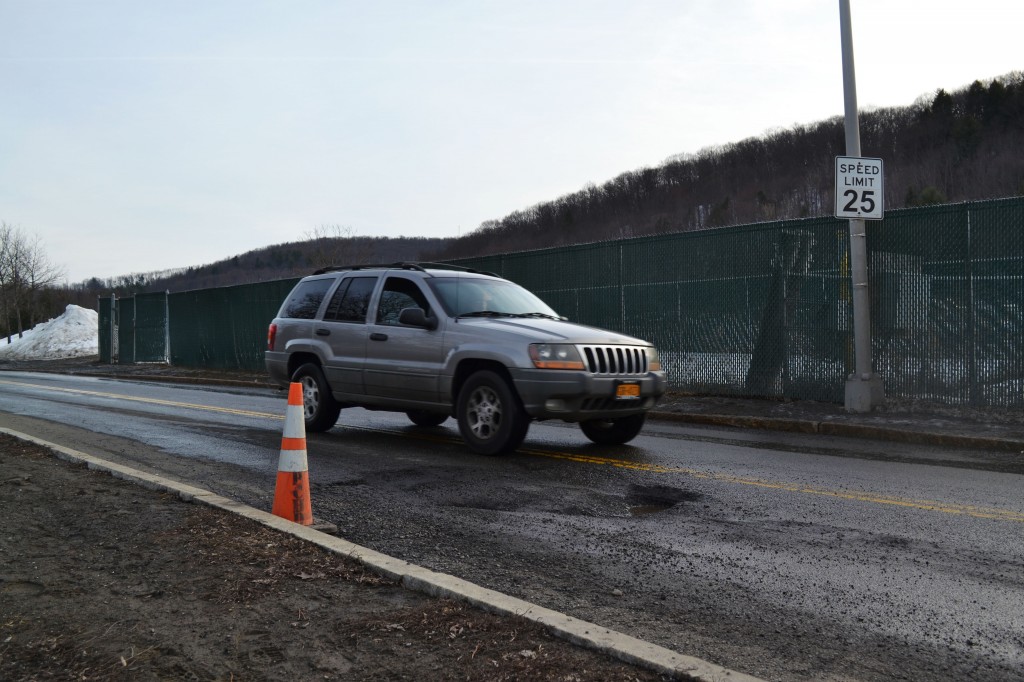
As one of the worst winters in recent history winds down, drivers at Binghamton University and the local area no longer need to worry about snowy nights and icy roads. The problem now is the number of potholes winter left behind.
Potholes occur when water seeps through cracks in pavement and freezes, causing it to expand and the pavement to break up. After the water melts and cars apply continuous pressure on the asphalt, potholes form.
Now, students, faculty and visitors to campus are looking for reassurance that the roads will be repaired soon. According to Karen Fennie, the communications specialist in physical facilities, the department has been cold patching holes all winter, but because of continued snow and freezing temperatures the patches are not lasting long. Cold patching uses room temperature asphalt to fill holes, but according to her, the only truly effective way to fix the problem is with hot asphalt.
“We can take temporary measures, cold patching, but really it depends on when the asphalt plants open up and weather that is above freezing and relatively dry,” Fennie wrote in an email.
Fennie said the physical facilities grounds crew hopes to begin the correction measures soon.
“We have contacted all black top plants within a 60 mile radius but none are opening until April,” Fennie wrote. “Next week we hope to use a piece of equipment from the City of Binghamton that will allow us to fill holes with hot material/asphalt that is more effective.”
In the meantime, drivers are hoping that the University can take other steps to keep them safe. Therese Cingranelli, a political science professor at BU, said that it would be helpful if some areas with significant damage were roped off or rerouted.
“I understand they can’t do anything until the weather is nice, but maybe some areas could have warnings, or some dangerous areas could be cautioned off,” Cingranelli said.
Cingranelli added that without such precautions, the risk is more than just damaging to the cars. The University is risking on-campus collisions as well.
“What ends up happening is that people are trying to avoid potholes, so they’re going in to the other lane, and that could be dangerous, too,” Cingranelli said.
After Harrison Teich, a sophomore majoring in English, was the passenger in a vehicle that had a tire ruined by a pothole on campus, he said he fears for the safety of his own car.
“The roads are so narrow, I have to wait for oncoming traffic to pass so I can swerve around them,” Teich said. “I notice they’re really big and very deep, so it’s just inconvenient.”
Although Off Campus College Transport (OCCT) has not had any issues or complaints regarding the potholes on campus, they have contacted the city of Binghamton regarding potholes off campus. Some riders said they have noticed the impact.
“It’s annoying to be tossed around when you’re standing on the bus,” said Ryan Cunningham, a sophomore majoring in mathematics. “When you hit a really bad spot, it’s definitely not fun.”
According to Ryan Fazziola, a sophomore majoring in theater, the potholes can cause expensive damages and the University should be making an effort to repair the problem.
“I hit a really bad bump turning onto Vestal Parkway from the main entrance and punctured my tire pretty badly,” Fazziola said. “I had to get a new tire and it threw my car out of alignment. It’s a burden on drivers and a huge safety issue. It would be nice to see the University and the city take action to fix up their roadways.”


